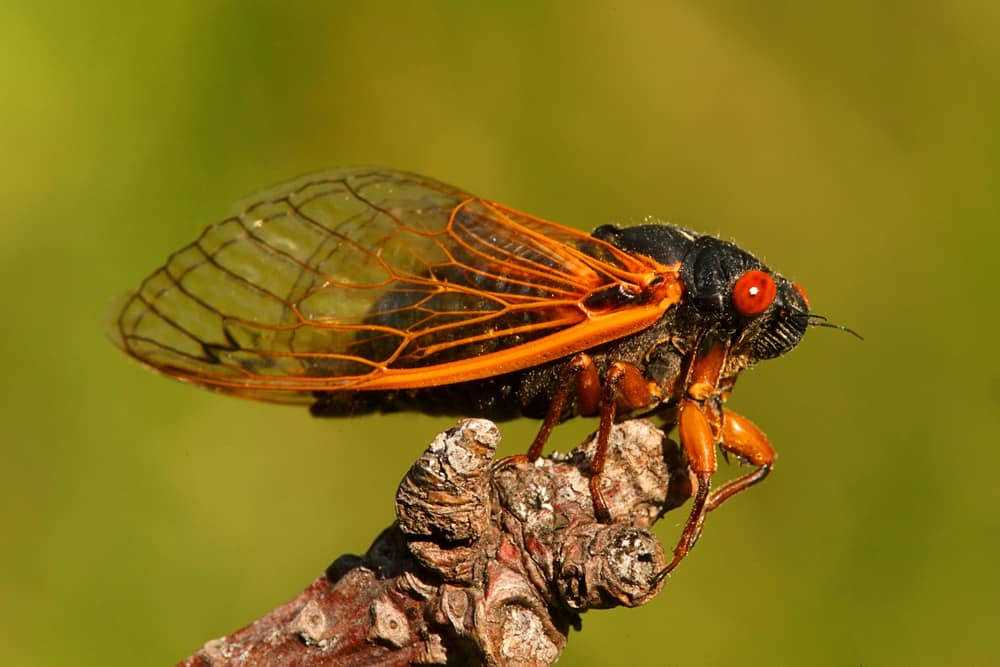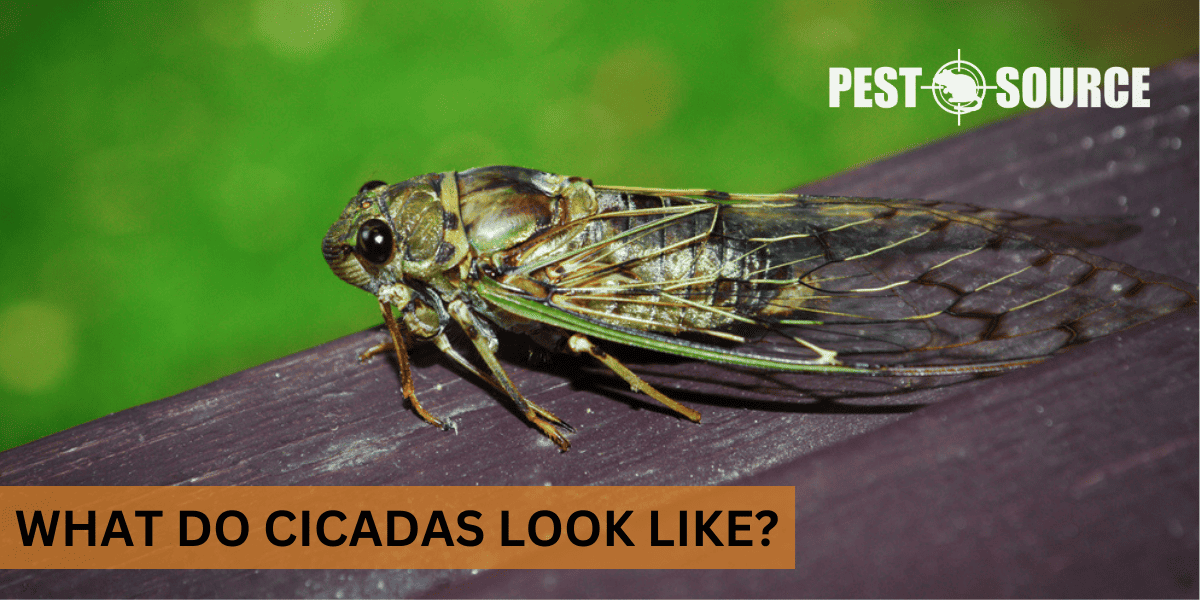Cicadas are recognized by their sizable, transparent wings and stout bodies, usually ranging in color from green to black. Their most distinctive features include large eyes set wide apart on their head and prominent veining in their wings. Dive deeper to explore the unique visual characteristics that differentiate cicada species.
POINTS
- Cicadas are robust, rounded insects with a broad head, prominent eyes, and can exhibit a range of colors and patterns, including shades of green, brown, and black.
- They possess six legs with the front set adapted for digging, and two pairs of wings that are transparent with a complex network of veins, sometimes highlighted with contrasting colors.
- Cicada coloration serves several functions, including camouflage against predators and potentially playing a role in attracting mates or signaling to other cicadas.
- Cicadas have a unique lifecycle, spending most of their lives as nymphs underground and emerging en masse for a brief but active adult stage focused on reproduction.
- There is no clear evidence that cicadas are attracted to specific colors, but their own coloration likely plays a role in survival, either through camouflage or as a defense mechanism to startle predators.
General Appearance of Cicadas
Cicadas are fascinating insects with a distinctive appearance that sets them apart from other insects. When you ask, “What does a cicada look like?” consider the following features: cicadas typically range in size from 0.75 to 2.25 inches in length, depending on the species. They have a robust, rounded body with a broad head and prominent eyes set wide apart on either side. Their color variations include shades of green, brown, black, and even some with vibrant patterns.
Defining Characteristics of Cicadas
The defining characteristics that distinguish cicadas from other insects include their large, transparent wings held roof-like over their bodies when at rest. They possess a set of clear, veined wings that can exhibit a range of colors and patterns. Another unique feature is their loud, buzzing call, produced by special organs called tymbals located on the sides of their abdominal base.
How Many Legs Do Cicadas Have?
Cicadas, like all insects, have six legs. These legs are jointed and emerge from the thorax, the middle part of their body. The front set of legs is specially adapted for digging, which cicada nymphs use to burrow underground where they spend most of their lives.
Cicadas’ Legs and Behavior
Cicadas use their legs for various behaviors that are integral to their lifestyle. Their strong hind legs aid in jumping, which can startle predators. The digging legs help nymphs navigate and construct their subterranean habitats. On trees, cicadas use their legs to climb and cling to bark, which is essential for their molting process and for positioning themselves to sing and attract mates.
How Many Wings Does a Cicada Have?
Cicadas are equipped with two pairs of wings, making a total of four wings. The front pair is larger and more robust, while the hind pair is slightly smaller. These membranous wings can display remarkable patterns, often with a complex network of veins that may be highlighted with colors contrasting their primarily transparent nature.
Wingspan and Wing Shape Variations
Different cicada species can have variations in wingspan and wing shape. For example, some species may have broader wings or longer wingtips, which can influence their flight patterns. The wings not only serve the purpose of flight but also play a role in cicada communication, as the fluttering sounds can be part of their mating calls.
Cicada Color Variations: Are All Cicadas Green?

While many people commonly associate cicadas with the color green, not all cicadas are green. Cicadas exhibit a range of colors, including various shades of brown and black, and some species have striking patterns with vibrant hues such as red or orange.
The Significance of Cicada Coloration
Cicada coloration is not just for show; it serves several functions in their life cycle and habitat. Green cicadas tend to blend in with foliage, providing camouflage against predators. Brown or darker-colored cicadas may be better adapted to certain environments, like tree bark, or to absorb heat. The color variations can also play a role in attracting mates or signaling to other cicadas.
Cicada Anatomical Characteristics
Diving deeper into cicada anatomy reveals a set of features finely tuned for survival. When discussing “cicada characteristics,” it’s essential to note their large, compound eyes, which provide them with a broad field of vision. These eyes are crucial for detecting movement and navigating their environment, particularly when flying or evading predators.
Cicada Eyes and Other Features
Cicada eyes are notable not just for their size but also for their position on the head, which allows for almost a 360-degree view. The “green cicada bug” also has three small, simple eyes (ocelli) located on the top of its head, which detect light and darkness. Additionally, cicadas have two antennae that serve as sensory organs, helping them to feel their surroundings and detect chemical signals.
What Behaviors Are Typical of Cicadas?
When considering “what do cicadas do,” their lifecycle is particularly remarkable. Cicadas are known for their periodic emergence from the ground, which can range from every year to every 17 years, depending on the species. Once they emerge, cicadas engage in a frenzy of activity, primarily focused on reproduction.

Lifecycle and Breeding Habits
Cicadas spend the majority of their lives underground as nymphs, feeding on sap from tree roots. When they emerge, they molt for the final time, becoming adults ready to mate. Males sing to attract females, using their tymbals to produce loud, distinctive calls. After mating, females lay eggs in slits they cut into the bark of trees. When the eggs hatch, the new nymphs drop to the ground and burrow to start the cycle anew.
Unique Behavioral Traits
Cicadas also exhibit unique behaviors such as synchronized emergence, which helps overwhelm predators with sheer numbers, ensuring the survival of enough cicadas to continue the species. They are also known for their “mass exodus” from the ground, creating a spectacle as they molt and ascend to the trees en masse.
Are Cicadas Attracted to Certain Colors?
The relationship between cicadas and colors is a topic of interest, particularly regarding attraction and camouflage. While there is no definitive evidence that cicadas are attracted to specific colors, their own coloration likely plays a role in survival and mating.
Color Attraction and Defense
Cicadas’ colors may not necessarily attract them to similar hues; instead, their coloration can serve as a defense mechanism, helping them blend into their environment to avoid predators. Additionally, the bright flashes of color found on some cicadas’ wings can startle predators, giving them a chance to escape.
Where Do Cicadas Live?
Cicadas live primarily above ground in temperate and tropical climates, favoring wooded and forested regions where they can find trees and shrubs to feed on plant sap. They spend the majority of their lives as nymphs underground, emerging only to mate and lay eggs. In the United States, the Midwest and Eastern states are particularly known for populations of periodical cicadas, which emerge in large broods every 13 or 17 years. Other cicada species, known as annual or “dog-day” cicadas, have a more widespread distribution and can be found in various regions during the summertime.



